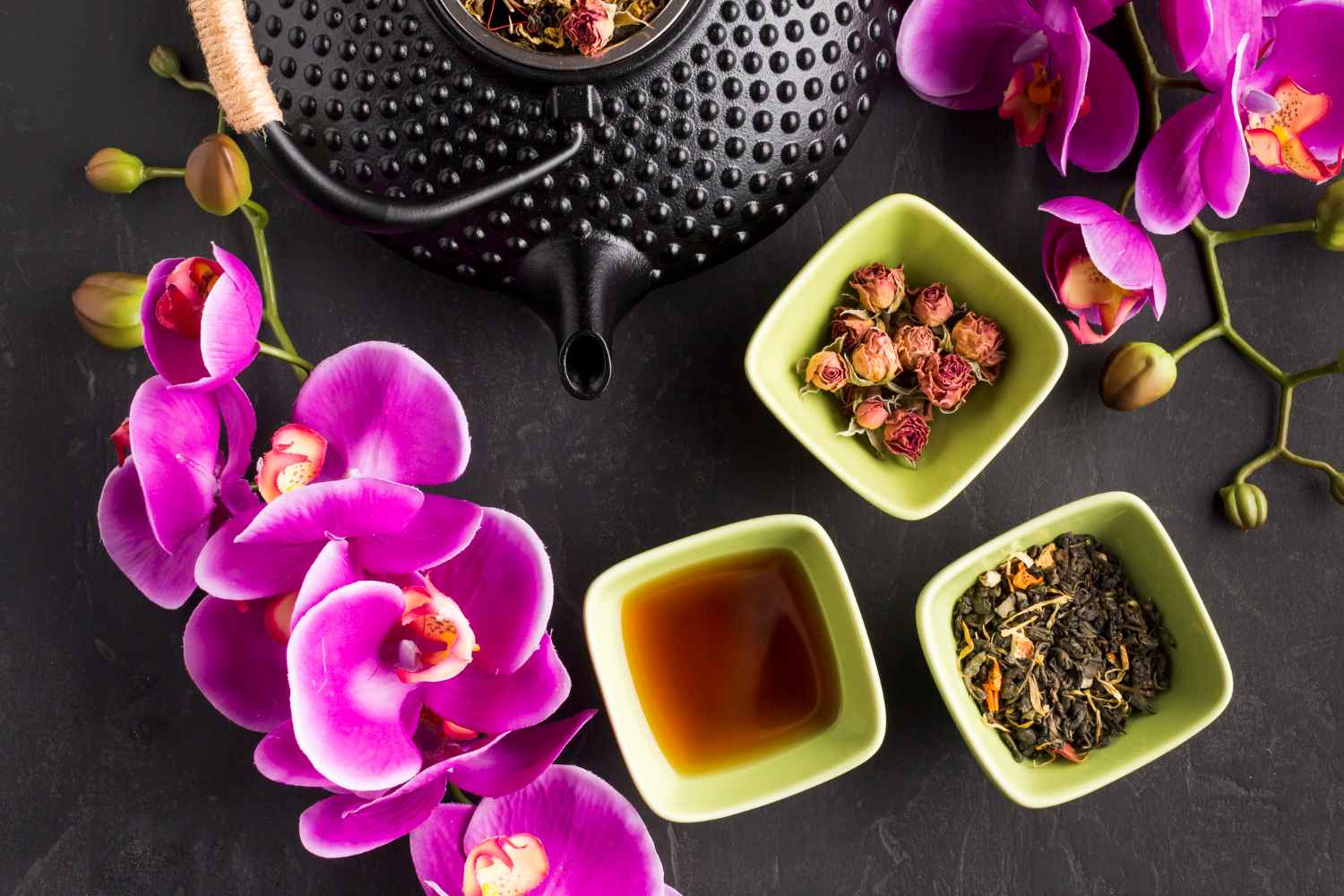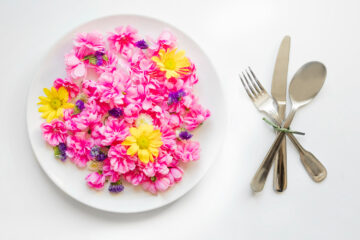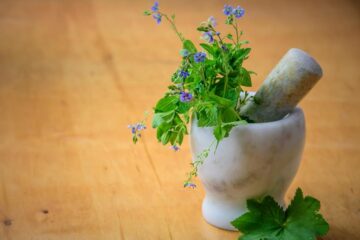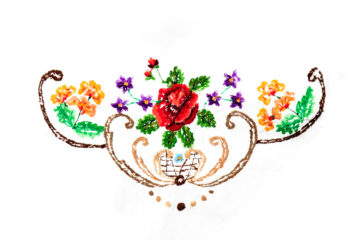Transform your garden into a scented paradise with aromatic flowers like lavender, jasmine, gardenias, lilacs, and roses. Their unique fragrances will uplift your senses while adding breathtaking color. Don’t overlook lesser-known gems like heliotrope, nicotiana, moonflower, sweet alyssum, and phlox, which offer delightful scents and attract pollinators. Position your fragrant blooms near seating areas and pathways to maximize their aromatic impact. For ideal growth, tailor your care routine to each flower’s sunlight and watering needs. Interested in creating sensory pathways or bringing these scents indoors? There’s much more to explore to enrich your garden experience.
Popular Aromatic Flowers
To make your garden a fragrant oasis, consider planting popular aromatic flowers like lavender, jasmine, gardenias, lilacs, and roses.
Each of these blooms offers a unique and pleasing scent that can enhance your outdoor space.
Let’s explore how these flowers can transform your garden into a sensory delight.
Lavender
Lavender, with its soothing scent and vibrant purple blooms, is a must-have for any aromatic garden. This perennial herb isn’t just beautiful; its fragrance is known for promoting relaxation and reducing stress. When you plant lavender, you’re not only adding a splash of color but also creating a calming atmosphere right in your backyard.
To grow lavender successfully, choose a sunny spot in your garden. Lavender thrives in well-drained soil, so if your garden soil is heavy or clay-like, consider using raised beds or adding sand to improve drainage. Water the plants moderately, as lavender prefers dry conditions and can suffer from root rot if overwatered.
Pruning is essential to keep your lavender healthy and encourage more blooms. Trim the plants back by about one-third after the first bloom in the spring, and again lightly in the fall. This practice helps maintain a compact, attractive shape and promotes vigorous growth.
Lavender isn’t just for the garden; you can harvest its flowers for various uses. Dry the blooms to make fragrant sachets, or use them in culinary dishes to add a unique flavor. With lavender, your garden becomes a sensory delight.
Jasmine
Incorporate jasmine into your garden for its enchanting fragrance and delicate white flowers.
Jasmine is a favorite among gardeners not only for its beauty but also for its ability to transform any outdoor space with its sweet scent. Whether you’re a seasoned gardener or just starting out, jasmine can be a delightful addition to your garden.
To successfully grow jasmine, keep these tips in mind:
- Sunlight: Jasmine thrives in full to partial sun. Make sure it gets at least 4-6 hours of sunlight daily.
- Soil: Well-draining soil is essential. Jasmine doesn’t like soggy roots, so make certain your soil has good drainage.
- Watering: Keep the soil consistently moist, but avoid over-watering. Jasmine prefers slightly damp conditions.
Whether you plant it in a pot on your patio or along a garden fence, jasmine’s intoxicating aroma will make your outdoor space more inviting.
Plus, the flowers attract beneficial pollinators like bees and butterflies, enhancing your garden’s ecosystem.
With a bit of care, you’ll enjoy the mesmerizing scent and beauty of jasmine all season long.
Gardenias
Another exquisite choice for adding fragrance to your garden is gardenias, known for their creamy white blossoms and rich, sweet scent. You’ll love how these elegant flowers can transform your outdoor space into a haven of tranquility and beauty. They thrive best in warm climates and need partial shade and acidic, well-drained soil. By providing the right conditions, you’ll be guaranteed with an abundance of blooms and an unforgettable aroma.
Gardenias are not just visually appealing; their scent is legendary and often used in perfumes. Planting them near windows or patios guarantees that their intoxicating fragrance wafts through your home and garden. They can be a bit finicky, requiring regular watering and protection from frost, but their stunning blooms make the effort worthwhile.
Here’s a quick guide to help you care for gardenias:
| Care Aspect | Recommendation |
|---|---|
| Light | Partial shade |
| Soil | Acidic, well-drained soil |
| Watering | Regular, but not waterlogged |
Lilacs
Lilacs, with their clusters of delicate, fragrant blooms, are a beloved choice for anyone looking to add both beauty and scent to their garden. These hardy shrubs thrive in well-drained soil and full sun, making them a relatively low-maintenance option. You’ll love the way their sweet aroma fills the air, creating a serene and inviting outdoor space.
To help you get started with lilacs, keep these tips in mind:
- Choose the Right Variety: There are many types of lilacs, from common lilac (Syringa vulgaris) to dwarf varieties. Select one that complements your garden’s size and style.
- Plant in the Right Spot: Lilacs need at least six hours of sunlight each day. Make sure to plant them in a sunny location to guarantee they thrive.
- Prune Regularly: Pruning right after they bloom helps maintain their shape and encourages more flowers next year.
Planting lilacs won’t only beautify your garden but also provide a delightful fragrance that can be enjoyed throughout the blooming season.
Roses
Roses, known for their timeless beauty and intoxicating scent, are a classic choice for any garden. You can’t go wrong with adding these elegant flowers to your landscape. They come in a variety of colors and types, from hybrid teas to climbing roses, each offering its unique fragrance and charm. Whether you’re a seasoned gardener or a beginner, roses provide a rewarding experience.
To start, choose a sunny spot in your garden, as roses thrive with at least six hours of sunlight daily. Make sure the soil is well-draining and rich in organic matter. When planting, dig a hole twice as wide as the root ball and incorporate compost to give your roses a good start. Water them deeply but infrequently to encourage deep root growth.
Don’t forget to prune your roses in early spring. This promotes healthy growth and abundant blooms. Regularly deadhead spent flowers to keep your plants looking their best and to encourage continuous blooming. Finally, keep an eye out for pests and diseases; early detection and treatment can save your roses.
With the right care, roses will reward you with stunning blooms and delightful aromas season after season.
Lesser-Known Fragrant Flowers
Now, let’s explore some lesser-known fragrant flowers that can add unique scents to your garden.
Consider planting heliotrope, nicotiana, moonflower, sweet alyssum, and phlox to introduce enchanting aromas.
Each of these flowers offers distinct fragrances that will enhance your garden’s sensory appeal.
Heliotrope
Heliotrope, with its clusters of deep purple and white flowers, offers a unique and enticing fragrance that’s perfect for adding a touch of the exotic to your garden. Known for its delightful vanilla scent, heliotrope is an excellent choice if you’re looking to diversify your collection of aromatic plants. These flowers not only smell amazing but also bring a burst of color that can brighten up any space.
Planting heliotrope is straightforward and rewarding. Here’s why you should consider adding it to your garden:
- Long Blooming Season: Heliotrope blooms from summer to the first frost, giving you months of enjoyment.
- Attracts Pollinators: Bees and butterflies love heliotrope, helping to create a lively, buzzing garden.
- Versatile: It can be grown in containers, hanging baskets, or directly in the ground, making it suitable for various garden layouts.
Adding heliotrope to your garden is a surefire way to enhance its sensory appeal. You’ll love the combination of visual beauty and aromatic delight that these flowers bring. Give them a spot in your garden, and let their exotic fragrance enchant you.
Nicotiana
If you’re looking to expand your garden’s aromatic repertoire, consider adding the lesser-known but equally fascinating Nicotiana. These delightful flowers, often called flowering tobacco, offer a unique fragrance that intensifies during the evening hours, making them perfect for moonlit garden strolls.
You’ll find Nicotiana blooms in a variety of colors, including white, pink, and lime green. Their tubular flowers attract pollinators like moths and hummingbirds, adding not only scent but life to your garden.
Planting Nicotiana is straightforward; they thrive best in well-drained soil with ample sunlight but can tolerate partial shade. Regular watering will keep them looking their best, but be mindful not to overwater.
One of the most appealing features of Nicotiana is its long blooming period. These flowers can grace your garden from late spring until the first frost, providing months of aromatic delight. Additionally, Nicotiana plants are relatively low-maintenance and can be grown from seeds or transplants, making them an excellent choice for both novice and experienced gardeners.
Incorporate Nicotiana into your garden layout, and you’ll be rewarded with their enchanting scent and charming appearance, enhancing your outdoor space in a subtle yet fascinating way.
Moonflower
One enchanting addition to your garden’s evening allure is the moonflower, known for its enchanting fragrance and large, white blooms that open at dusk. This lesser-known beauty can transform your nighttime garden into a serene, aromatic haven. The moonflower, with its velvety petals and sweet scent, provides a sensory experience that’s hard to match.
Planting moonflowers is straightforward. They thrive in well-drained soil and full sun but are happiest when they can climb. Consider placing them near a trellis or fence to let their vines stretch out and their blossoms shine. As the sun sets, you’ll witness the magic of their blooms unfurling, releasing an aroma reminiscent of sweet almonds.
Here are some quick tips to help you get started with moonflowers:
- Watering: Keep the soil consistently moist but not waterlogged.
- Spacing: Plant seeds or seedlings about 6-12 inches apart to allow room for growth.
- Support: Use a trellis, fence, or even a pergola to support their climbing habit.
Sweet alyssum
As the moonflower enchants your evenings, sweet alyssum can bring a delightful fragrance to your garden throughout the day. This lesser-known flower is small but mighty when it comes to adding a sweet aroma to your outdoor space. Sweet alyssum produces clusters of tiny, white, purple, or pink flowers that aren’t only visually appealing but also emit a honey-like scent.
You’ll find that sweet alyssum is incredibly easy to grow. It’s versatile, thriving in both garden beds and containers. Plant it in a sunny spot, and it will reward you with continuous blooms from spring through fall. The plant is also drought-tolerant once established, making it a low-maintenance option for busy gardeners.
To get the best results, sow sweet alyssum seeds directly into the soil after the last frost. Within a few weeks, you’ll notice the first blooms, and soon after, the charming fragrance will fill the air. Sweet alyssum is also a great companion plant, attracting beneficial insects like bees and butterflies to your garden.
Incorporating sweet alyssum into your garden not only enhances its beauty but also its scent, making your garden a sensory delight day and night.
Phlox
Have you considered adding phlox to your garden for a burst of color and an enchanting fragrance? This lesser-known flower is a fantastic choice if you want to diversify your garden’s aromatic profile. Phlox varieties come in a wide range of colors, from vibrant pinks and purples to soothing whites and blues, making them perfect for any garden scheme.
Phlox thrives in well-drained soil and can adapt to both full sun and partial shade. Their star-shaped blooms not only add visual interest but also release a sweet, subtle scent that’s especially noticeable in the evening. These flowers are also relatively low-maintenance, making them a great option for both novice and experienced gardeners.
Here’s why you should consider planting phlox:
- Versatility: Phlox can be used as ground cover, in borders, or even in containers.
- Attract Pollinators: These flowers are a magnet for butterflies and hummingbirds, enhancing your garden’s ecosystem.
- Long Blooming Season: Enjoy their vibrant colors and fragrance from spring through late summer.
Designing a Fragrant Garden
Creating a fragrant garden involves selecting aromatic flowers that complement each other and planning their placement for ideal scent distribution.
Begin by choosing a mix of flowers with different blooming periods. This guarantees you’ll enjoy delightful fragrances from spring through fall. Think about combining classics like roses, lavender, and jasmine for a diverse scent profile.
Next, consider the layout. Place highly fragrant flowers near seating areas, pathways, or entry points. This way, you’ll get a burst of aroma as you walk by or relax outside. Layering scents can also be effective; plant taller, aromatic blooms like lilacs behind shorter ones such as sweet alyssum or dianthus.
Think about the wind direction in your garden. Position your most fragrant flowers where the wind can carry their scents throughout the space.
Additionally, group plants together that release their fragrances at different times of the day. For example, morning glories bring a lovely morning scent, while evening primrose and night-blooming jasmine release their aromas at dusk.
Growing and Care Tips
To keep your fragrant garden thriving, focus on the specific growing and care needs of each aromatic flower. Start by understanding that different flowers have different requirements for sunlight, watering, and soil conditions.
First, verify you plant your aromatic flowers in the right location. Sun-loving flowers like lavender and jasmine need at least six hours of direct sunlight daily. Conversely, gardenias and lilies prefer partial shade.
Tailoring your watering schedule is equally important. Overwatering can lead to root rot, while underwatering will stress the plants and diminish their scent.
Next, consider the soil quality. Most aromatic flowers flourish in well-drained soil. Adding organic compost can enhance soil fertility and drainage.
Regular pruning is also essential to encourage new growth and maintain shape. Prune your flowers just after they bloom to remove spent blooms and dead stems.
Here are some quick tips to keep your fragrant garden in top shape:
- Sunlight: Match the plant’s sunlight needs to your garden’s exposure.
- Watering: Water consistently and adjust based on the plant’s specific needs.
- Soil: Use well-drained soil and amend with organic compost.
Using Aromatic Flowers
Aromatic flowers can transform your space into a sensory haven, offering both visual beauty and delightful scents. You can use these fragrant blooms in various creative ways to enhance your garden and home. Start by planting them near windows, doorways, or patios where their scent can easily drift indoors. This way, you’ll enjoy their perfume even when sitting inside.
Consider cutting a few stems to create aromatic bouquets for your living spaces. Place them in vases around your home to bring the garden indoors and keep the air fresh. You can also dry aromatic flowers like lavender and rose petals to make potpourri or sachets for your closets and drawers, keeping your clothes smelling wonderful.
In the garden, use aromatic flowers to design sensory paths or seating areas. Imagine walking through a pathway flanked by fragrant blooms that release their scent as you brush past. Additionally, mix these flowers with herbs like rosemary and mint for an aromatic herb garden that’s both beautiful and practical.
Lastly, consider combining aromatic flowers with other plants to create a balanced ecosystem. Many fragrant flowers attract beneficial insects, helping to naturally control pests in your garden.
To Wrap It Up
Incorporating aromatic flowers into your garden can transform it into a sensory paradise.
You’ll love the popular choices as well as the lesser-known gems, each offering unique scents.
By thoughtfully designing your fragrant garden and following the care tips, you’ll guarantee a thriving, aromatic haven.
Don’t forget to use these blooms indoors for added enjoyment.
Immerse yourself in the world of fragrant flowers and watch your garden become a delightful retreat that you’ll cherish every day.





